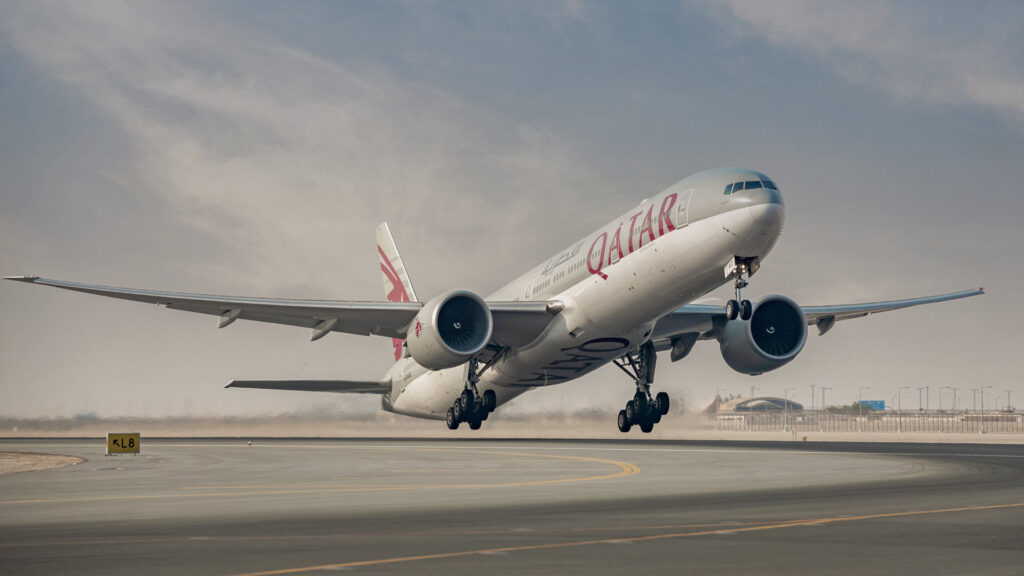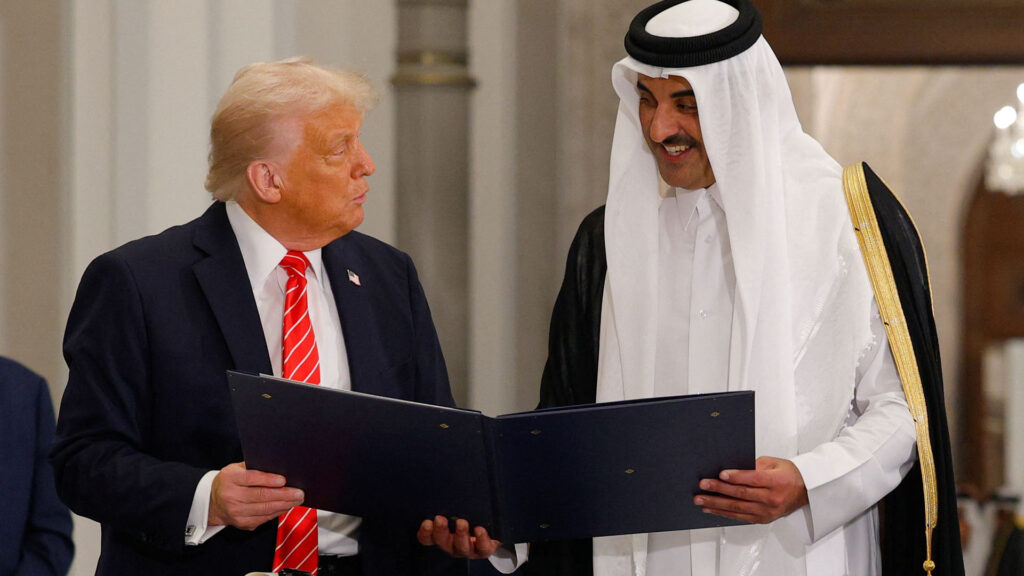Qatar Airways has placed the largest widebody aircraft order in Boeing’s history, signaling the global aviation industry’s strong resilience and growth. This landmark development highlights the sector‘s positive trajectory.
The ceremonial signing, which took place in Doha on May 14, 2025, was attended by high-profile dignitaries, including U.S. President Donald Trump and the Amir of Qatar, His Highness Sheikh Tamim bin Hamad Al Thani. This highlights the geopolitical significance of this commercial agreement.
The deal, encompassing up to 210 widebody jets, including 130 Boeing 787 Dreamliners and 30 777X aircraft, with options for an additional 50 planes, represents a pivotal moment in aviation history. Beyond its immediate commercial implications, this agreement has a substantial economic impact for the United States, supporting approximately 400,000 jobs across Boeing’s extensive supply chain.
Highlights
- Qatar Airways places record-breaking order for up to 210 Boeing widebody aircraft, including 130 787 Dreamliners and 30 777X planes
- The deal marks Boeing’s largest-ever widebody order and Qatar Airways’ largest aircraft purchase in its history
- The agreement will support nearly 400,000 American jobs across Boeing’s supply chain
- U.S. President Donald Trump and Qatar’s Amir Sheikh Tamim bin Hamad Al Thani personally witnessed the signing ceremony
- The order positions Qatar Airways to expand its global network while investing in fuel-efficient fleet modernization
Strategic Fleet Expansion
The magnitude of this order reflects Qatar Airways’ ambitious growth strategy as it seeks to solidify its position among the world’s premier carriers. With this purchase, the Doha-based airline will become the Middle East’s largest operator of the 787 Dreamliner, an aircraft lauded for its fuel efficiency and passenger comfort.
“This so we can meet the strong demand in the airline as we seamlessly connect passengers to the world better than anyone,” said Qatar Airways Group Chief Executive Officer Engr.

Badr Mohammed Al-Meer emphasized that the carrier’s strategy extends beyond mere expansion.
“After two consecutive years of record-breaking commercial performance and with this historic Boeing aircraft order, we’re not simply chasing scale, we’re building strength that will allow us to continue to deliver our unmatched products and customer experiences.”
The airline currently operates more than 150 Boeing aircraft, including existing 777 and 787 models for passenger and cargo operations. This latest acquisition doubles down on Boeing’s widebody offerings, which align with Qatar Airways’ focus on long-haul international routes connecting through its Doha hub.
Environmental Considerations in Fleet Modernization
Notably, the announcement places considerable emphasis on Qatar Airways’ fleet modernization program’s environmental benefits. The 787 Dreamliner family delivers a reported 25% improvement in fuel efficiency compared to the previous-generation aircraft it replaces, while the 777X is designed to reduce fuel consumption and emissions by a similar margin.

This focus on sustainability reflects growing industry awareness of aviation’s environmental footprint. As the International Air Transport Association (IATA) continues to push for carbon-neutral growth and eventually net-zero carbon emissions, fleet renewal represents one of the most immediate and effective strategies airlines can employ to reduce their environmental impact.
As the first Middle Eastern airline to receive the highest level of IATA’s Environmental Assessment certification, Qatar Airways is positioning this order as part of its broader sustainability initiatives. The carrier was also the first globally to be certified to the industry standard for preventing illegal wildlife trafficking, having signed the Buckingham Palace Declaration in March 2016.
Economic and Geopolitical Dimensions
The presence of U.S. President Donald Trump and Qatar’s Amir Sheikh Tamim bin Hamad Al Thani at the signing ceremony underscores the geopolitical dimensions of this commercial transaction. With approximately 400,000 American jobs supported by this order, the economic benefits extend far beyond Boeing’s immediate operations.
This development comes at a critical time for Boeing, which has faced significant challenges in recent years related to its 737 MAX program and production issues across its commercial lineup. The vote of confidence from a prestigious carrier like Qatar Airways may help bolster Boeing’s market position vis-à-vis its European competitor, Airbus.
From Qatar’s perspective, this massive investment in American-made aircraft could strengthen bilateral relations with the United States. Qatar hosts Al Udeid Air Base, home to thousands of U.S. troops and a forward headquarters of the U.S. Central Command, making aviation deals part of a broader strategic relationship.

Industry Context: Post-Pandemic Recovery
This historic order comes as the global aviation industry continues its recovery from the unprecedented disruption caused by the COVID-19 pandemic. According to ICAO’s Economic Impact Analysis, international passenger traffic has been steadily rebuilding, though demand patterns have evolved in the post-pandemic landscape.
The recovery has presented challenges and opportunities for Middle Eastern carriers like Qatar Airways, which rely heavily on connecting traffic between continents. The airline’s focus on premium service and its strategic location between Europe, Asia, and Africa has allowed it to capitalize on the resurgence in international travel.
Industry analysts at CAPA – Centre for Aviation note that widebody fleet renewal is accelerating globally as airlines seek to capture recovering long-haul demand with more efficient aircraft. Qatar Airways’ move may prompt similar decisions from competitors, potentially triggering a new cycle of fleet modernization across the industry.
Hamad International Airport as a Global Hub
Hamad International Airport is central to Qatar Airways’ expansion strategy, which has received multiple accolades, including “World’s Best Airport” by Skytrax in 2021, 2022, and 2024. The airport’s continued development as a global connecting hub is intrinsically linked to Qatar Airways’ fleet strategy.

Following recent expansions, Hamad International Airport has the capacity to handle over 58 million passengers annually. This provides Qatar Airways with the infrastructure necessary to grow its network, which currently encompasses over 170 destinations worldwide.
The efficient operation of next-generation aircraft like the 787 Dreamliner and 777X will enhance the airline’s ability to offer competitive connecting times through Doha, potentially strengthening its position against rival Middle Eastern hubs in Dubai and Abu Dhabi.
Looking Forward: Implications for Global Aviation
As Qatar Airways takes delivery of these new aircraft in the coming years, the competitive dynamics of international air travel may shift accordingly. The airline’s expanded capacity and enhanced efficiency could lead to increased market share on key intercontinental routes.
Meanwhile, Boeing solidified its relationship with a key Middle Eastern customer when the manufacturer was working to restore its reputation and stabilize its commercial aircraft business. This vote of confidence benefits the 787 Dreamliner program, in particular.

For travelers, Qatar Airways’ introduction of these new aircraft promises enhanced comfort and potentially more route options as it leverages its expanded fleet to serve additional destinations or increase frequencies on existing routes.
As the aviation industry continues to navigate post-pandemic recovery, sustainability pressures, and evolving passenger expectations, this historic order may well be remembered as a defining moment in the sector’s transformation.



